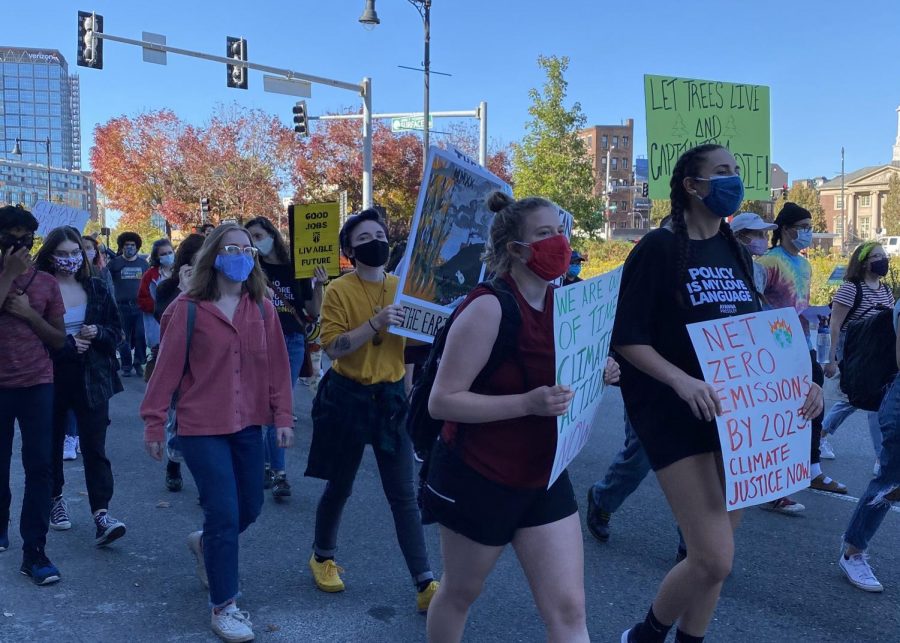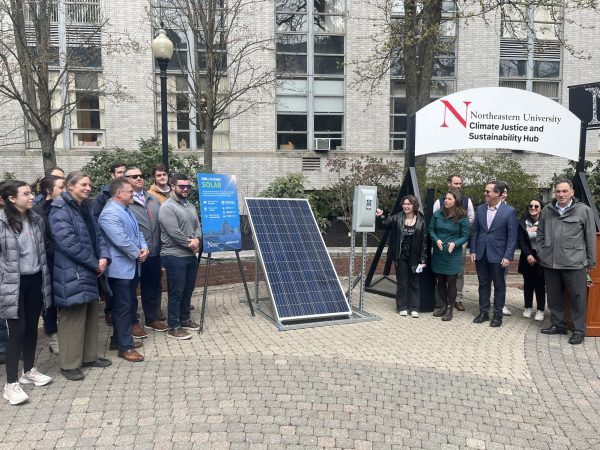Op-ed: Solving climate change starts from the bottom-up
People demonstrate at the Climate Justice Strike Oct. 15, 2020.
February 10, 2021
During the past four years, climate policy has been a heavily debated topic, especially after the United States withdrew from the Paris Climate Agreement in 2017. Since then, confusion, misinformation and extremism have soared. From phasing out air travel to reviving the coal industry, American climate policy is stuck between two factions in a much deeper ideological battle.
This is an ideological battle, mostly as a result of the two-party system. I wish it was just about the environment, but it goes so far beyond that. Neither side wants to budge from their standpoint, because doing so would ruin their credibility. With both parties unable to compromise, there is very little hope for finding a solution that would satisfy both sides. For instance, it is not possible to protect all jobs in fossil fuel sectors; they will eventually, and inevitably, be phased out. Similarly, it is not realistic to implement drastic measures to combat climate change, as this will have massive social and economic ramifications. A compromise between these two extremes must occur in order to tackle climate change. We must start a steady transition phase that will allow those affected by job cuts to find employment elsewhere while new technology makes the transition over to clean sources of energy much cheaper.
It’s unlikely that this ideological battle between the two political parties is going to weaken in the next few years. Changing the political dynamic, especially at such a high level of government, takes a lot of time — precious time we simply do not have. Therefore, any change implemented from the top down is going to be slow and weak. If we are going to make real progress on climate action, we need to start taking steps ourselves and implement change using a bottom-up approach.
In politics, it is harder to gain support for a policy that will benefit a large group in a small way over one that will benefit a small group in a large way. This principle is known as Olson’s law of large groups, and it lays the foundation for lobbying. Lobbying is another reason American climate policy is slow to change. Over $200 million is spent each year lobbying against new climate policies like enhanced emissions regulations and carbon taxes, mostly by large fossil fuel-based conglomerates that have a major stake in climate policy. Even a small policy change can ruin their revenues for years to come. Combine that with the fact that it is very hard to diversify from the oil business, and the result is a group of people who will do almost anything to prevent legislation such as the Green New Deal from getting passed through Congress.
Given that climate change is a global issue, collaboration between countries can quickly get bogged down as every nation continues to pursue its own national interests. For example, former President Donald J. Trump pulled the United States out of the Paris Climate Agreement because it gave China and India a free hand to continue using fossil fuels while the U.S. had to switch over to renewables. Why should the United States spend so much money, and take the resulting economic blow when China and India are simply going to keep pumping more CO2 into the atmosphere?
Answering this question is tricky. While the deal is definitely unfair toward the United States, what really matters is whether Americans think it is a good deal for them. Imposing an unfair deal from the top down is wrong, and would probably cost the government votes in the next election. However, if it is supported from the bottom up, then it is only fair that the deal is enacted regardless of how unfair it seems to be.
Large scale top-down change is further hindered by the current state of energy technology. Many solutions simply cannot be fully implemented in a short amount of time. For example, as much as environmentalists would like to completely transition to renewable forms of energy production, that is simply not possible. Clean energy sources such as wind and solar polar are alone incapable of sustaining the growing energy demand of the nation today; large installations are also simply way too expensive and unreliable with current technology.
So, what can we do about it? First and foremost, we need to change the modern political environment. Negotiations between the two parties should not be viewed as zero-sum, but rather a potential victory for both sides and the nation as a whole. For example, the recently passed coronavirus stimulus bill was held up in Congress for seven months as neither the Democrats nor the Republicans were willing to budge from their positions. It was passed only when they decided to draft a bill based on the points they agreed upon, rather than continue to bicker over whatever differences they might have in order to maintain their party image. The end result? Tens of thousands of lives were unnecessarily lost and even more unemployed. Some even accuse Congress of abdicating its responsibility by delaying the bill for so long.
Secondly, more investment should be made by the federal and state governments, either directly or indirectly through tax breaks, to individuals and companies researching nuclear energy or working toward achieving carbon neutrality. This is a great way to incentivize green policies on a smaller scale, which will then add up to create a much larger impact. Microgeneration grants are also another means of encouraging a bottom-up approach to wean our dependency on fossil-fuel based power sources. Tax breaks given by the state and federal government to households that have installed Tesla power walls is a great example of this.
While nuclear power is not the most popular source of clean energy, it is a much better way to cut carbon emissions than solar or wind. It is cheaper, more reliable and actually generates less waste all while creating massive amounts of power. Despite events such as Fukushima and Chernobyl, nuclear power remains one of the safest methods of energy generation we know today.
Finally, people need to receive accurate information about current policy, proposed changes and the impact that these changes will have on them rather than the highly politicized interpretations the media spreads today. I not only think that this information will help mitigate the spread of fake news, but it will also enable people to make educated choices on what changes they want to see.
The United States is and will continue to be limited by the problems we just discussed. Therefore, the federal government can only take limited action on climate policy, which is exactly what we have seen so far. It is up to the people to push for change from the bottom-up. For instance, if we want to support companies that are carbon neutral, then we should buy their products over other competitors that are not. This will force companies to adapt much faster than any piece of legislation would.
I firmly believe that climate policy cannot be enforced from the top down — it needs to be supported by the people from the bottom up. Only then can we effect real change that will combat global environmental degradation and create a brighter future for our nation.
Rahul Rao is a first-year computer science and politics combined major. He can be reached at [email protected]


















